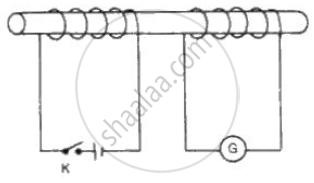Advertisements
Advertisements
प्रश्न
Define the unit of current.
उत्तर १
The unit of electric current is ampere (A). 1 A is defined as the flow of 1 C of charge through a wire in 1 s.
उत्तर २
The unit of electric current is ampere (A). When 1 C of charge flows through a conductor in 1 s, it called 1 ampere (A) current.
I = `Q/t`
उत्तर ३
The SI unit of the electric current is ampere (A). The current flowing through a conductor is said to be one ampere when a charge of one coulomb flows across any cross-section of a conductor in one second. Hence,
1 ampere = \(\frac{1 \text { coulomb }}{1 \text { second }}\).
APPEARS IN
संबंधित प्रश्न
Calculate the number of electrons constituting one coulomb of charge.
Three 2 V cells are connected in series and used as a battery in a circuit.
How many joules of electrical energy does 1 C gain on passing through (i) one cell (ii) all three cells?
Which particles constitute the electric current in a metallic conductor?
In which direction do electrons flow?
Why should the resistance of:
a voltmeter be very large?
What happens to the other bulbs in a parallel circuit if one bulb blows off?
The lamps in a house hold circuit are connected in parallel because:
(a) this way they required less current
(b) if one lamp fails the others remain lit
(c) this way they require less power
(d) if one lamp fails the other also fail
State three factors on which the heat produced by an electric current depends. How does it depend on these factors?
A wire of length 5 m has a resistance of 2.0 Ω calculate:
(a) the resistance of wire of length 1 m
(b) the equivalent resistance if two such wires each of length 2 m are joined in parallel.
(c) the resistance of 1 m length of wire of same material but of half diameter.
State the relation between work, charge and potential difference for an electric circuit.
The following table shows the current in Amperes and potential differences in Volts.
- Find the average resistance.
- What will be the nature of the graph between the current and potential difference? (Do not draw a graph.)
- Which law will the graph prove? Explain the law.
| V (volts) | I (amp) |
| 4 | 9 |
| 5 | 11.25 |
| 6 | 13.5 |
The work done in moving unit positive charge across two points in an electric circuit is a measure of
Find the effective resistance in the following circuit diagrams (Fig.):

The following appliances are to be used on 240 V supply. Calculate the current used by each and say which fuse, 2 amp, 5 amp or 13 amp should be incorporated with each, (i) A television rated at 150 W, (ii) An electric iron rated at 750 W, (iii) An immersion heater rated at 3000 W, (iv) A hair dryer rated at 500 W. How much will it cost to run the television set for 100 days for an average of 4 hours a day at 60 paise per unit?
What is the function of a step-up transformer?
The circuit diagram in fig shows two coils of an insulated copper wire wound on a cardboard tube. G is a center zero galvanometer.

(a) Describe what will happen when th e swi tch K is cl osed for severa l
seconds and then opened again .
(b) What will be the effect of repeating the experiment with an iron placed in the tube?
An electric iron is rated 750 W, 230 V. Calculate the electrical energy consumed by the press in 16 hours.
A bulb marked 12 V, 24 W operates on a 12 V battery for 20 minutes. Calculate:
- The current flowing through it, and
- The energy consumed.
An electric bulb is rated 250 W, 230 V.
- the energy consumed in one hour, and
- the time in which the bulb will consume 1.0 kWh energy when connected to 230 V mains.
Three heaters each rated 250 W, 100 V are connected in parallel to a 100 V supply. The resistance of each heater
A geyser is rated 1500 W, 250 V. This geyser is connected to 250 V mains. Calculate:
- The current drawn,
- The energy consumed in 50 hours, and
- The cost of energy consumed at ₹ 4.20 per kWh.
What is the speed of electric current?
MCB is used to protect household electrical appliances.
Coulomb is the SI unit of ____________.
A current of 1 A is drawn by a filament of an electric bulb. Number of electrons passing through a cross section of the filament in 16 seconds would be roughly
1020 electrons, each having a charge of 1.6 x 10-19 C, flows in a circuit V is 0.1s. What is the current in ampere?
Match the items in column-I to the items in column-II:
| Column - I | Column - II |
| (i) electric current | (a) volt |
| (ii) potential difference | (b) ohm meter |
| (iii) specific resistance | (c) watt |
| (iv) Electrical power | (d) joule |
| (v) electrical energy | (e) ampere |
